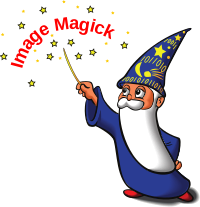ImageMagick

ImageMagick logo
|
|

Screenshot of display, with menu
|
|
| Original author(s) | John Cristy |
|---|---|
| Developer(s) | ImageMagick Studio LLC |
| Initial release | August 1, 1990 |
| Stable release |
7.0.4-10 / 18 February 2017
|
| Repository | git |
| Written in | C |
| Operating system | Cross-platform |
| Type | Image manipulation |
| License | ImageMagick License |
| Website | imagemagick |
| Author | ImageMagick Studio LLC |
|---|---|
| DFSG compatible | Yes |
| GPL compatible | Yes |
| Linking from code with a different license | Yes |
ImageMagick is a free and open-sourcesoftware suite for displaying, converting, and editing raster image and vector image files. It can read and write over 200 image file formats.
ImageMagick was created in 1987 by John Cristy when working at DuPont, to convert 24-bit images (16 million color) to 8-bit images (256-color), so they could be displayed on most screens. It was freely released in 1990 when DuPont agreed to transfer copyright to ImageMagick Studio LLC, still currently the project maintainer organization.
In May 2016, it was reported that ImageMagick had a vulnerability through which an attacker can execute arbitrary code on servers that use the application to edit user-uploaded images. Security experts including CloudFlare researchers observed actual use of the vulnerability in active hacking attempts.
The software mainly consists of a number of command-line interface utilities for manipulating images. ImageMagick does not have a robust graphical user interface to edit images as do Adobe Photoshop and GIMP, but does include – for Unix-like operating systems – a basic native X Window GUI (called IMDisplay) for rendering and manipulating images and API libraries for many programming languages.
Execute the following on Linux or UNIX to launch the GUI:
Otherwise, images may be edited directly by various command-line parameters without launching a GUI at all. The program uses magic numbers to identify image file formats.
...
Wikipedia
